Ruger 6.5 Creedmoor Review
By John Johnston
Bill Ruger was a giant in the firearms world. Yes, some of the Ruger line has had some ups and downs over the years but with each problem there was a solution that made them stronger. My first single shot center fire rifle was a beautiful Ruger #1. In the early days you could pay a little more for better wood and that rifle had a very well figured walnut stock. Ruger currently makes five of their rifle models in the 6.5 Creedmoor. It is the 77VT and the Ruger#1V that will interest the long range shooter.
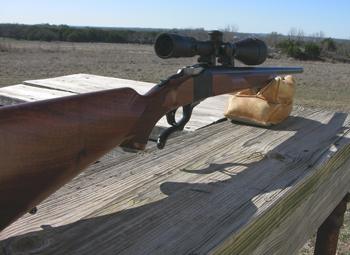
You have to admire the classic lines of the #1.
First let's look at the 6.5 Creedmoor cartridges. Hornady developed this round at the suggestion of Dennis Demille, general manager of Creedmoor Sports and Dave Emary , senior ballistician for Hornady. They were looking for a cartridge that could get the accuracy and velocity of the .260 Remington but with longer bullets. The real kicker was they had to fit in the standard .308 length magazine. There were other conditions to be considered in the development of this round. Since Ruger and Hornady already had a close relationship with the Ruger Compact Magnum line of cartridges, it was only natural for Ruger to make production rifles for this new 6.5 Creedmoor.
With five different offerings in the Creedmoor line, Hornady has come out with affordable ammunition for the long range shooter or hunter compared to the two bullet weights offered by Remington in the .260 when it started. Hornady's bullet weights go from 120 to 140 grains. Hornady actually puts the reloading information on their standard velocity ammunition but not the "Superformance". However, I am sure sooner or later, if not already, that secret will be out.
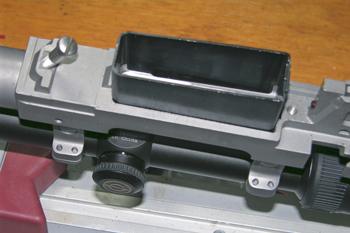
Note the slanted front action screw which helps lock the action in tight.
The first rifle I tested was the Ruger 77VT. This bolt action is stainless steel with a medium varmint taper 28 inch barrel. Ruger sends with each new rifle a pair of their proprietary rings that fit the bases which are milled into the top of the action. These rings are for up to a 44mm objective scope with a 1 inch tube. If you want larger or higher rings you can send the rings you get when you purchase a rifle back to Ruger for an exchange. Even though this set up is very good for the average hunter, the long range shooter will find it a problem. It can easily be dealt with by the addition of scope base adaptors by Burris and then the use of Burris Zee rings. This combination can gain the shooter up to 30moa.
Looking around my shop I had only two scopes on hand that I could use with the factory rings supplied, so a Simmons 4-12x40 side focuses was mounted. Even though this rifle scope combination shot some great groups, I cannot recommend this scope. The point of impact changed with a change of power and part of the side focus turret fell off in my hand. I am sure Simmons would have replaced it if I wanted to send it back and wait. Ruger has never been known for having the best triggers in the world but this 77VT came with a trigger that weighed in at an average 1lb 10oz. on my digital trigger scale. The trigger was crisp and broke sharply. In other words, I liked it.
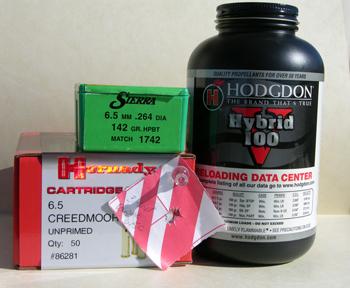
The components I used to shoot this group, which was the smallest I could attain.
The factory ammunition was first up and I ran thorough all Hornady had to offer. The best group I could get was with the 140 grain which shot slightly less than 3/4 inch. Now you may be thinking that accuracy should be good enough but being an old reloader, I always think my reloads can do better.
Two target rounds were developed that could shoot less than ½ inch groups. The first was using the 139gr. Lapua Scenar bullet over 40.2 grains of H4350 with an OAL of 2.76". This round averaged a velocity of 2701FPS. The best group was using a Sierra 142gr. HPBT Match bullet over 41.5 grains of Hybrid 100V, with an OAL of 2.77" at a velocity of 2711fps. For a hunting load I came up with Berger 140gr VLD/HUNTING bullet over 35.8 grains of Varget, with an OAL of 2.72". This load shot just less than 3/4" at 2641 fps. This rifle definitely favored the heavier bullets. This rifle shot at least MOA with all the ammunition and reloads I tried.
So what makes this rifle so accurate? First, I believe it is plain old good quality workmanship and materials. The design is simple but one thing that Ruger does is lock in their actions by slanting the front action screw, so as you tighten it down it pulls the action in tighter. On this rifle the good trigger pull definitely helped me shoot better groups. The stock was laminated, which should keep the action in tight.
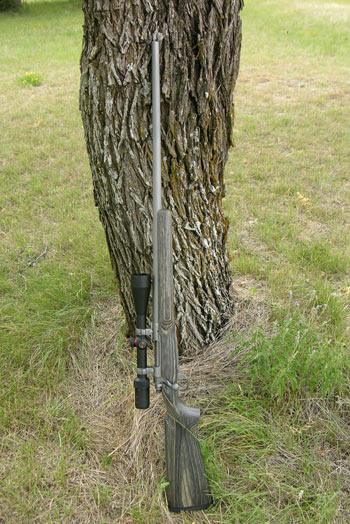
The Ruger 77VT as tested.
The second rifle tested was a Ruger #1V. Unlike the 77VT the trigger was factory set at 4lbs. 3oz. It had one redeeming factor; it was a very crisp trigger. The varmint model is my favorite #1 because it has a medium taper heavy barrel and the scope bases are attached directly to the barrel. I have had many Ruger #1's over the years. The early ones had adjustable triggers, but no more.
I noticed a couple of things on this new rifle I did not particularly care for: the safety was not curved to fit the contour of the tang and the wood was left proud (high) where it met the metal. This was a standard way of doing the fitting over the years on this model, but this sample was just a little too high for my taste. This may seem like nit-picking but the #1 was their top of the line for many years and I just expected better.
I mounted this new #1 with a Weaver scope, 6.5x20-44 A/O. Again this would not be considered a long range scope but it did fill my needs for a scope to test loads and groups. This scope's clarity, fit and function seemed very good scope in this price range. You can see for yourself how well it performed.
The rifle's chamber was pretty tight, especially in the throat area. All the new Hornady brass had to be re-sized first, and even then some of the rounds required a slight push to get them to chamber. I use a Lee priming tool and have for years. I noticed some of the brass fit the suggested shell holder and some did not. It was not a real problem since I just moved up one size and it worked fine. This does mean to me that the rims may vary slightly in thickness.
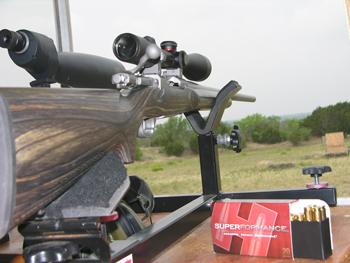
The Ruger 77VT ready for the tests to begin.
After trying a lot of loads that got as large as 2", I found the mother lode for hunting and accuracy. First you start with once fired brass (this rifle likes it), then add 40grs. of IMR4350 and seat a Berger 140gr. VLD/Hunting bullet to an overall length of 2.82". This produced a five shot ragged hole. The same load with a 140gr. Hornady Amax with the same OAL produced a group just slightly larger than the Berger's, both loads clocked in just shy of 2600fps.
Either one of these rifles, with the proper optical setup could be a fine long range rifle. I would probably change the trigger on the #1 to something I can adjust down to about 2.5 lbs. or less. Both rifles like the Berger and Hornady 140 gr. Bullets, but this was no surprise due to the fact that the round was designed around the 140gr. Amax bullet.
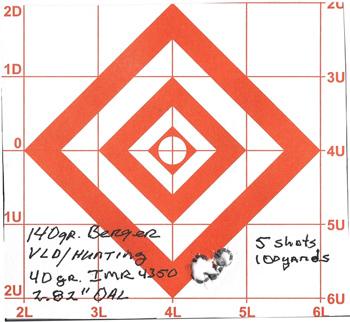
This was the best group I could get out of the #1 but I think this accuracy would be sufficient for most shooters.
The 6.5 Creedmoor was built to fill a certain niche in the long range competitions but it certainly has spread into a lot of manufacturers' cartridge line ups. I just heard that even Browning will be chambering the A Bolt rifle in the Creedmoor. Ruger is spreading the Creedmoor's virtues on their sponsored television hunting shows, and why not? The 6.5 may be a very accurate caliber but it can also be a very effective hunting round. So if you were wondering if the 6.5 Creedmoor was just a flash in the pan, only time will tell, but at this point, I would bet it will be around for a long time.
By John Johnston
Bill Ruger was a giant in the firearms world. Yes, some of the Ruger line has had some ups and downs over the years but with each problem there was a solution that made them stronger. My first single shot center fire rifle was a beautiful Ruger #1. In the early days you could pay a little more for better wood and that rifle had a very well figured walnut stock. Ruger currently makes five of their rifle models in the 6.5 Creedmoor. It is the 77VT and the Ruger#1V that will interest the long range shooter.

You have to admire the classic lines of the #1.
First let's look at the 6.5 Creedmoor cartridges. Hornady developed this round at the suggestion of Dennis Demille, general manager of Creedmoor Sports and Dave Emary , senior ballistician for Hornady. They were looking for a cartridge that could get the accuracy and velocity of the .260 Remington but with longer bullets. The real kicker was they had to fit in the standard .308 length magazine. There were other conditions to be considered in the development of this round. Since Ruger and Hornady already had a close relationship with the Ruger Compact Magnum line of cartridges, it was only natural for Ruger to make production rifles for this new 6.5 Creedmoor.
With five different offerings in the Creedmoor line, Hornady has come out with affordable ammunition for the long range shooter or hunter compared to the two bullet weights offered by Remington in the .260 when it started. Hornady's bullet weights go from 120 to 140 grains. Hornady actually puts the reloading information on their standard velocity ammunition but not the "Superformance". However, I am sure sooner or later, if not already, that secret will be out.

Note the slanted front action screw which helps lock the action in tight.
The first rifle I tested was the Ruger 77VT. This bolt action is stainless steel with a medium varmint taper 28 inch barrel. Ruger sends with each new rifle a pair of their proprietary rings that fit the bases which are milled into the top of the action. These rings are for up to a 44mm objective scope with a 1 inch tube. If you want larger or higher rings you can send the rings you get when you purchase a rifle back to Ruger for an exchange. Even though this set up is very good for the average hunter, the long range shooter will find it a problem. It can easily be dealt with by the addition of scope base adaptors by Burris and then the use of Burris Zee rings. This combination can gain the shooter up to 30moa.
Looking around my shop I had only two scopes on hand that I could use with the factory rings supplied, so a Simmons 4-12x40 side focuses was mounted. Even though this rifle scope combination shot some great groups, I cannot recommend this scope. The point of impact changed with a change of power and part of the side focus turret fell off in my hand. I am sure Simmons would have replaced it if I wanted to send it back and wait. Ruger has never been known for having the best triggers in the world but this 77VT came with a trigger that weighed in at an average 1lb 10oz. on my digital trigger scale. The trigger was crisp and broke sharply. In other words, I liked it.

The components I used to shoot this group, which was the smallest I could attain.
The factory ammunition was first up and I ran thorough all Hornady had to offer. The best group I could get was with the 140 grain which shot slightly less than 3/4 inch. Now you may be thinking that accuracy should be good enough but being an old reloader, I always think my reloads can do better.
Two target rounds were developed that could shoot less than ½ inch groups. The first was using the 139gr. Lapua Scenar bullet over 40.2 grains of H4350 with an OAL of 2.76". This round averaged a velocity of 2701FPS. The best group was using a Sierra 142gr. HPBT Match bullet over 41.5 grains of Hybrid 100V, with an OAL of 2.77" at a velocity of 2711fps. For a hunting load I came up with Berger 140gr VLD/HUNTING bullet over 35.8 grains of Varget, with an OAL of 2.72". This load shot just less than 3/4" at 2641 fps. This rifle definitely favored the heavier bullets. This rifle shot at least MOA with all the ammunition and reloads I tried.
So what makes this rifle so accurate? First, I believe it is plain old good quality workmanship and materials. The design is simple but one thing that Ruger does is lock in their actions by slanting the front action screw, so as you tighten it down it pulls the action in tighter. On this rifle the good trigger pull definitely helped me shoot better groups. The stock was laminated, which should keep the action in tight.

The Ruger 77VT as tested.
The second rifle tested was a Ruger #1V. Unlike the 77VT the trigger was factory set at 4lbs. 3oz. It had one redeeming factor; it was a very crisp trigger. The varmint model is my favorite #1 because it has a medium taper heavy barrel and the scope bases are attached directly to the barrel. I have had many Ruger #1's over the years. The early ones had adjustable triggers, but no more.
I noticed a couple of things on this new rifle I did not particularly care for: the safety was not curved to fit the contour of the tang and the wood was left proud (high) where it met the metal. This was a standard way of doing the fitting over the years on this model, but this sample was just a little too high for my taste. This may seem like nit-picking but the #1 was their top of the line for many years and I just expected better.
I mounted this new #1 with a Weaver scope, 6.5x20-44 A/O. Again this would not be considered a long range scope but it did fill my needs for a scope to test loads and groups. This scope's clarity, fit and function seemed very good scope in this price range. You can see for yourself how well it performed.
The rifle's chamber was pretty tight, especially in the throat area. All the new Hornady brass had to be re-sized first, and even then some of the rounds required a slight push to get them to chamber. I use a Lee priming tool and have for years. I noticed some of the brass fit the suggested shell holder and some did not. It was not a real problem since I just moved up one size and it worked fine. This does mean to me that the rims may vary slightly in thickness.

The Ruger 77VT ready for the tests to begin.
After trying a lot of loads that got as large as 2", I found the mother lode for hunting and accuracy. First you start with once fired brass (this rifle likes it), then add 40grs. of IMR4350 and seat a Berger 140gr. VLD/Hunting bullet to an overall length of 2.82". This produced a five shot ragged hole. The same load with a 140gr. Hornady Amax with the same OAL produced a group just slightly larger than the Berger's, both loads clocked in just shy of 2600fps.
Either one of these rifles, with the proper optical setup could be a fine long range rifle. I would probably change the trigger on the #1 to something I can adjust down to about 2.5 lbs. or less. Both rifles like the Berger and Hornady 140 gr. Bullets, but this was no surprise due to the fact that the round was designed around the 140gr. Amax bullet.

This was the best group I could get out of the #1 but I think this accuracy would be sufficient for most shooters.
The 6.5 Creedmoor was built to fill a certain niche in the long range competitions but it certainly has spread into a lot of manufacturers' cartridge line ups. I just heard that even Browning will be chambering the A Bolt rifle in the Creedmoor. Ruger is spreading the Creedmoor's virtues on their sponsored television hunting shows, and why not? The 6.5 may be a very accurate caliber but it can also be a very effective hunting round. So if you were wondering if the 6.5 Creedmoor was just a flash in the pan, only time will tell, but at this point, I would bet it will be around for a long time.

